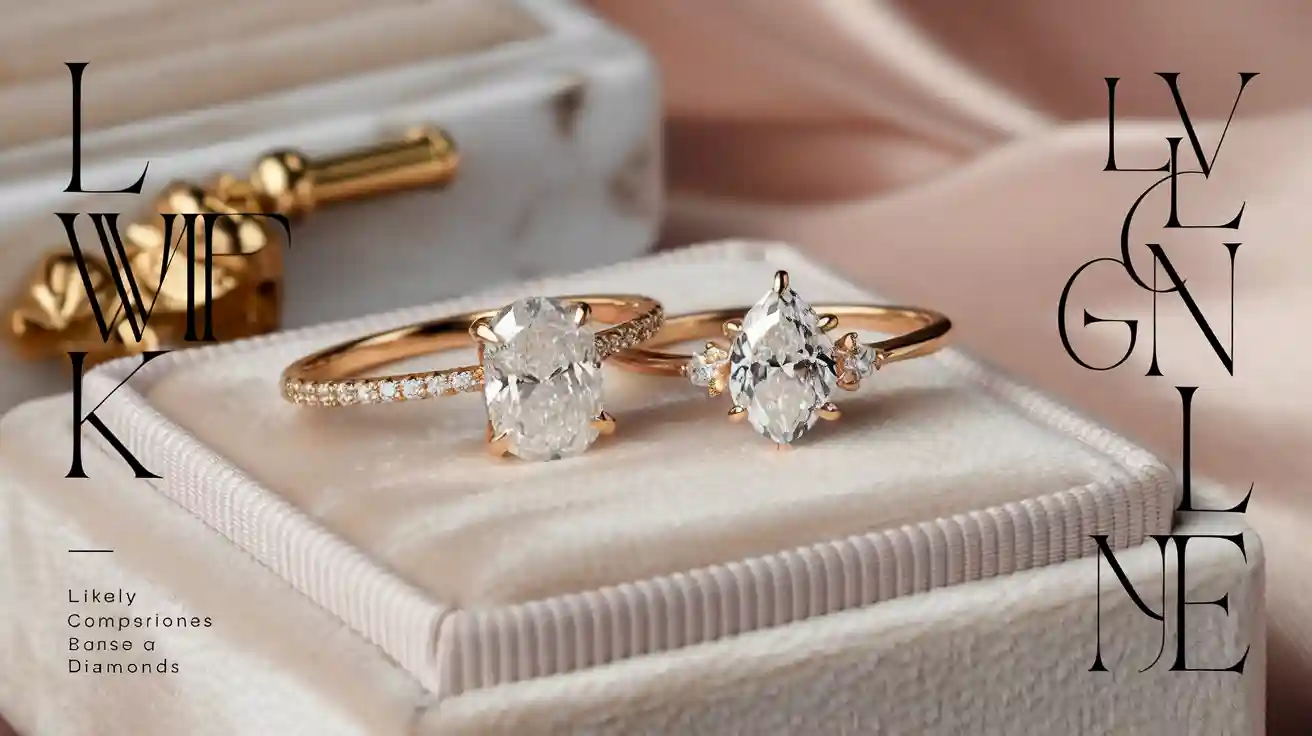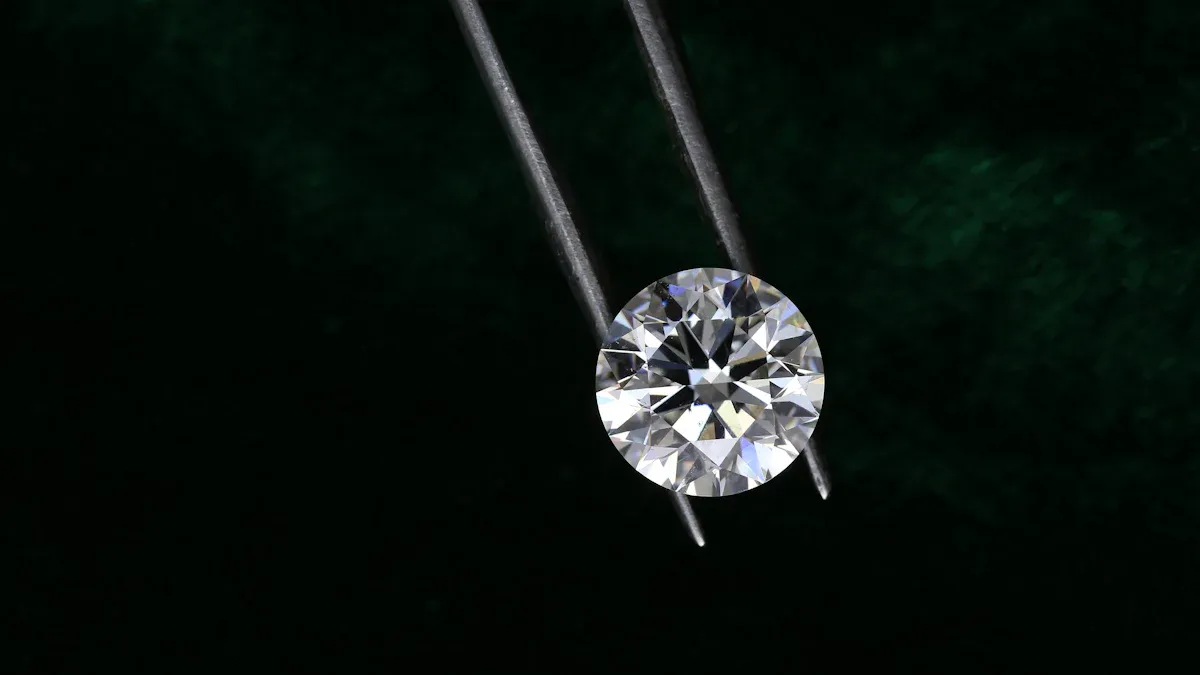
When choosing diamond rings for women, knowing the differences helps. Are lab-grown and natural diamonds alike? Are they both strong? These are good questions, especially for a ring that shows love.
Lab-grown diamonds are becoming more popular. Their market may grow from 34.07 billion USD in 2025 to 58.75 billion USD by 2034. They cost less and are practical, especially for sizes up to 2 carats. Knowing these facts helps you choose a ring that fits your values, budget, and life.
Key Takeaways
-
Lab-grown diamonds cost 30-85% less than natural ones. They are a great option for saving money.
-
Both lab-grown and natural diamonds are very strong. They score a 10 on the Mohs scale and can handle daily use.
-
Lab-grown diamonds are better for the environment. They create much less pollution than mining natural diamonds.
-
Picking between lab-grown and natural diamonds depends on your values. Think about cost, the environment, and tradition.
-
Always check for certification when buying diamonds. It proves they are real and high quality.
Understanding Lab-Grown and Natural Diamonds
What Are Lab-Grown Diamonds
Lab-grown diamonds are made in labs, not found in nature. They are real diamonds with the same look and feel as natural ones. The main difference is how they are created. Natural diamonds form deep underground over billions of years. Lab-grown diamonds are made quickly using advanced machines.
You might wonder how labs make these diamonds. Scientists use two methods: HPHT and CVD. HPHT uses heat and pressure like deep underground. CVD grows diamonds in a vacuum by adding carbon layers. Both ways create beautiful diamonds that look just like natural ones.
New technology has made lab-grown diamonds even better. For example:
-
Special tools like Raman spectroscopy improve diamond quality.
-
Laser treatments make them look even prettier.
-
Solar-powered machines make production eco-friendly.
These updates make lab-grown diamonds a smart, modern, and budget-friendly choice for jewelry fans.
What Are Natural Diamonds
Natural diamonds are Earth's treasures, formed over billions of years. They are made of carbon, just like lab-grown diamonds, but their creation is different. Natural diamonds form deep underground under high heat and pressure.
Volcanic eruptions bring these diamonds closer to the surface. Miners then find them in special locations. Natural diamonds are rare, which makes them special. Did you know there are only about 50 diamond mines in the world? This rarity makes them a symbol of beauty and value.
Each natural diamond has its own story. They are pieces of Earth's history, formed long ago. When you wear one, you carry a part of Earth's amazing journey.
How Are Lab-Grown and Natural Diamonds Formed
The way lab-grown and natural diamonds form is interesting. Knowing this helps you see their differences. Here's a simple comparison:
|
Origin |
Conditions |
Process Description |
|---|---|---|
|
Natural Diamonds |
Form deep underground, 70–120 miles below the surface. High pressure and heat shape them. |
Made under Earth's extreme conditions, then brought up by volcanoes. |
|
Lab-Grown Diamonds |
Made in labs using HPHT or CVD methods. |
HPHT uses heat and pressure; CVD adds carbon gas in layers. |
Natural diamonds form deep in the Earth, often under stable crust areas. Some come from even deeper places and are pushed up by volcanoes. Lab-grown diamonds, however, are made in weeks or months using machines.
HPHT copies Earth's natural process but costs more. CVD is easier to control and cheaper. Scientists can adjust settings to make large, high-quality diamonds.
Both types of diamonds are real and have unique qualities. Your choice depends on what you value—history, eco-friendliness, or cost.
Comparing Physical and Visual Properties

Chemical Composition of Lab-Grown and Natural Diamonds
Lab-grown and natural diamonds are made of the same material. Both are pure carbon arranged in a crystal pattern. This gives them identical physical and optical traits. You might ask, “How can I tell them apart?” Without special tools, you really can’t.
Lab diamonds are made with advanced machines for consistent quality. Natural diamonds form over billions of years underground. This process can create tiny flaws or slight color changes. These don’t change their chemical structure but make each natural diamond unique.
Appearance and Sparkle Differences
Lab and natural diamonds look almost the same to the eye. Both shine brightly and sparkle beautifully. Natural diamonds may have small flaws or color tints, making them special. Lab diamonds, made in controlled labs, are usually perfect.
Here’s a simple comparison to explain:
|
Property |
Lab-Grown Diamonds |
Natural Diamonds |
|---|---|---|
|
Visual Appearance |
May have unique flaws or color shades. |
|
|
Sparkle and Brilliance |
Shine just like mined diamonds. |
Might show small imperfections. |
|
Formation |
Made by humans using technology. |
Formed naturally over billions of years. |
No matter which you pick, both types of diamonds are stunning and sparkle beautifully.
Durability and Hardness of Lab Diamonds vs Natural Diamonds
Are lab diamonds as strong as natural ones? Yes, they are! Both score a 10 on the Mohs hardness scale. This makes them the hardest material on Earth. They resist scratches and chips equally well.
“Lab-grown and natural diamonds are the same in every important way. They share the same chemical structure, physical traits, and durability,” says Scott Berkebile, a gem expert from the Gemological Institute of America.
Whether you choose a lab or natural diamond, both are long-lasting. They’re great for daily wear and perfect for meaningful jewelry like rings.
Ethical Considerations for Diamond Rings for Women
Environmental Impact of Natural Diamonds
Natural diamonds are beautiful but harm the environment. Mining them damages the Earth a lot. To mine one carat, 250 tons of soil is moved. This causes deforestation and destroys animal habitats. It also harms plants and animals living nearby. Mining uses a lot of water and pollutes it with chemicals. This pollution affects fish and people living close to mines.
Mining also adds to climate change. Machines used in mining release greenhouse gases. About 57,000 grams of these gases are made per carat. After mining, the land is often left damaged. Some companies try to fix the land, but it’s not enough. Even with better practices, natural diamonds still leave a big environmental mark.
Ethical Advantages of Lab-Grown Diamonds
Lab-grown diamonds are better for the planet. They need less land and energy to make. For example, they release only 0.028 grams of greenhouse gases per carat. This is much less than natural diamonds. Lab diamonds also create very little waste, making them eco-friendly.
Another good thing is that lab diamonds are easy to track. You can know where they come from and be sure they are conflict-free. Special markings help keep their supply chain clear. This makes lab-grown diamonds a smart choice for people who care about the planet and fairness.
|
Metric |
Lab-Grown Diamonds |
Natural Diamonds |
|---|---|---|
|
Environmental Impact |
More habitat loss and higher emissions |
|
|
Traceability |
Easy to track and verify |
Harder to ensure conflict-free origins |
Social Responsibility in the Diamond Industry
The diamond industry has faced problems with fairness. Issues like conflict diamonds and bad working conditions are common. Programs like the Kimberley Process help make diamond sourcing legal and fair. This process works to stop conflict diamonds and improve practices.
Lab-grown diamonds help even more with social responsibility. They don’t need mining, so they avoid harming mining communities. Many jewelry companies now focus on being eco-friendly. Luxury brands are leading by being open and sustainable. These changes help communities and show that diamonds can be both beautiful and responsible.
Cost Differences Between Lab-Grown and Natural Diamonds
Why Lab-Grown Diamonds Cost Less
Lab-grown diamonds are cheaper than natural ones. Why is that? It’s because of how they’re made. Natural diamonds take billions of years to form underground. Lab-grown diamonds, however, are made in just weeks. This faster process lowers their cost.
Another reason is supply. More companies now make lab-grown diamonds. This increases competition and lowers prices. For example, a one-carat lab diamond costs about $500. A natural diamond of the same size costs $2,500. For two carats, lab diamonds cost $1,000, while natural ones cost $13,000 or more.
Lab-grown diamonds are also cheaper because they lack resale value. This makes them a budget-friendly choice for many buyers.
What Affects Diamond Prices
Several things affect diamond prices. The 4Cs—carat, clarity, color, and cut—are key. Bigger diamonds with fewer flaws and better cuts cost more.
The economy also matters. When people have more money, they buy more diamonds. This raises demand and prices. Other factors like currency rates and mining ethics also play a role. Many buyers now prefer lab-grown diamonds because they are easier to trace and more eco-friendly.
Lab-grown diamonds have also changed natural diamond prices. As lab diamonds become popular, natural diamonds face more competition. This might lower their prices in the future.
Long-Term Value of Lab-Grown vs Natural Diamonds
Natural diamonds hold their value better over time. They keep about 50% or more of their worth. Lab-grown diamonds, however, have little resale value. This is because they are easier to make, and their prices keep dropping as technology improves.
If you want a diamond as an investment, choose a natural one. But if you want a beautiful, affordable diamond for daily wear or special events, lab-grown diamonds are a great choice. They look just as stunning without the high price.
Sustainability and Environmental Impact
Carbon Footprint of Lab-Grown Diamonds
Lab-grown diamonds are better for the environment. They use less energy and create fewer greenhouse gases. New technology helps make them with renewable energy. For example, making one carat of lab diamonds causes much less pollution than mining natural ones.
Here’s how experts check diamond sustainability:
|
Source |
What It Focuses On |
|---|---|
|
AGTA Recommendation |
Uses life cycle assessments (LCA) to compare diamond impacts. |
|
SCS-007 Jewelry Sustainability Standard |
Tracks ethical practices, climate neutrality, and eco-friendly production. |
These rules ensure lab-grown diamonds meet green standards. They are a great choice for people who care about the planet.
Environmental Concerns with Natural Diamond Mining
Mining natural diamonds harms the Earth in many ways. It involves digging up large areas of land, which damages nature. Here are some problems caused by mining:
-
Soil becomes poor, hurting plants and animals.
-
Water gets polluted from dirty runoff.
-
Dust and machines make the air unhealthy.
These problems show how mining affects the environment. Lab-grown diamonds are a cleaner and safer option.
Which Option Is More Sustainable
Lab-grown diamonds are much more eco-friendly than natural ones. They need less water, don’t destroy forests, and create fewer emissions. This makes their environmental impact much smaller.
If you want a diamond that matches your green values, pick lab-grown. They are beautiful, strong, and better for the planet. It’s a smart and caring choice.
Certification and Quality Assurance
Why Certification Matters for Diamond Rings
Buying a diamond ring? Certification is super important. It’s like a diamond’s report card, showing its quality and if it’s real. Without it, you might not know if the diamond is worth the price. Trusted groups like the American Gem Society (AGS) and Gemological Institute of America (GIA) are known for their strict rules.
-
AGS uses advanced tools and grades diamonds from 0 to 10. A grade of 0 is the best.
-
GIA is famous for grading the 4Cs: cut, color, clarity, and carat weight.
-
If you care about cut quality, AGS certification is highly recommended.
A certified diamond gives you confidence. It proves the ring is as good as it looks.
How Lab-Grown and Natural Diamonds Are Certified
Lab-grown and natural diamonds get certified in similar ways. Experts check their cut, clarity, carat weight, and color. Certificates from trusted labs like IGI (International Gemological Institute) and GIA are highly valued.
-
IGI focuses on grading lab-grown diamonds, especially their color and clarity.
-
GIA now certifies lab-grown diamonds with reports like those for natural ones.
These certificates prove the diamond’s quality and where it came from. They also help you learn what makes your diamond special, whether it’s lab-grown or natural.
Tips for Buying High-Quality Diamond Rings
Want the perfect diamond ring? Follow these tips:
-
Learn about the 4Cs: cut, color, clarity, and carat.
-
Know the right ring size for a comfy fit.
-
Shop from trusted stores like James Allen or Blue Nile. They offer great deals and warranties.
-
Pick a style and design that matches your taste.
By doing this, you’ll get a beautiful ring that’s worth every dollar.
Choosing the Right Diamond Ring for Women
Budget Tips for Lab-Grown and Natural Diamonds
When buying a diamond ring, your budget matters a lot. Lab-grown diamonds are cheaper and great for saving money. They cost 30-85% less than natural diamonds. This means you can buy a bigger or better diamond without spending too much. For example, a one-carat lab diamond might cost $1,420, while a natural one could be $9,770. That’s a big price gap!
However, lab-grown diamonds lose value faster than natural ones. A lab diamond might lose up to 80% of its value. Natural diamonds usually lose around 60%. Even so, lab diamonds cost less upfront, so the total money lost is smaller.
If you’re on a budget, try these ideas:
-
Buy diamonds just under popular sizes, like 0.9 carats instead of 1 carat.
-
Check financing plans, but read the terms carefully.
-
Save money before buying to avoid going into debt.
Lab-grown diamonds are a smart choice for saving money. But if keeping value over time is important, natural diamonds might be worth the extra cost.
Matching Your Choice to Your Values
Your diamond ring choice reflects what you care about. Do you value the environment, fairness, or tradition? Lab-grown diamonds are eco-friendly and don’t involve mining, which can harm nature and people.
Natural diamonds are rare and have a long history. They’ve been used in engagement rings for centuries. If you love tradition and timeless beauty, natural diamonds might be your pick.
Here’s what studies say about how values affect ring choices:
|
Aspect |
Findings |
|---|---|
|
Social Pressure |
Many feel pressure to spend more on engagement rings. |
|
Personal Meaning |
Most agree rings show love and commitment. |
|
Shared Decisions |
Couples often decide together when buying a ring. |
|
Cost Opinions |
Some think expensive rings mean success, others don’t. |
Think about what matters to you and your partner. Whether it’s being eco-friendly, honoring tradition, or staying on budget, choose a ring that fits your shared values.
Easy Tips for Picking the Best Diamond Ring
Choosing a diamond ring doesn’t have to be hard. Focus on what you and your partner want most. Here are some simple tips to help:
-
Learn your partner’s style. Does she like classic or modern designs?
-
Find her ring size to avoid resizing later.
-
Understand the 4Cs: cut, color, clarity, and carat. These affect quality and price.
-
Consider lab-grown diamonds for a cheaper, eco-friendly option.
-
Shop online for better deals. Online stores often have lower prices than local shops.
Here’s a quick look at average engagement ring costs:
|
Source |
Average Cost |
|---|---|
|
American Express Spending Tracker |
$2,311 |
|
Jewelers of America Cost of Doing Business Report |
$4,000 |
|
TheKnot Survey |
$5,598 |
Set a budget that works for you. Experts suggest spending about 2.9% of your yearly income on a ring. Use tools to compare prices and find the best deal.
Remember, the perfect ring isn’t just about the diamond. It’s about what it means—your love and promise. Take your time, research, and pick a ring that feels right for both of you.
Deciding between lab-grown and natural diamonds depends on your priorities. Lab-grown diamonds are cheaper and better for the environment, making them a top pick. Since early 2022, their sales have grown 20% more than natural diamonds. Natural diamonds, however, are rare and have a rich history. They form deep in the Earth over millions of years.
Think about what matters to you—your budget, values, and lifestyle. Do you want a bigger, flawless diamond for less money? Or do you love the unique charm of a natural diamond? Whatever you choose, let it match what’s important to you. A diamond isn’t just about its shine—it’s about its meaning. 💎
FAQ
How are lab-grown diamonds different from natural diamonds?
Lab-grown diamonds are made in labs with special machines. Natural diamonds form underground over billions of years. Both are made of the same material and shine the same, but lab-grown diamonds cost less and are better for the environment.
Are lab-grown diamond wedding rings strong?
Yes, they are very strong! Lab-grown diamonds are as tough as natural ones. They score 10 on the Mohs scale, meaning they can last forever, just like natural diamonds.
Can you see a difference between lab-grown and natural diamond earrings?
No, you can’t tell them apart just by looking. Both shine brightly and look clear. Only experts using special tools can figure out if a diamond is lab-grown or natural.
Are cultured diamonds and lab-grown diamonds the same?
Yes, they are the same thing. Cultured diamonds is another name for lab-grown diamonds. Both are made in labs and look just as beautiful as natural diamonds.
Why is lab-grown diamond jewelry cheaper?
Lab-grown diamonds cost less because they don’t need mining or take millions of years to form. Labs make them quickly and efficiently, which lowers the price.




